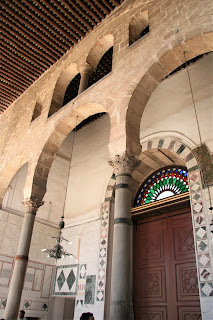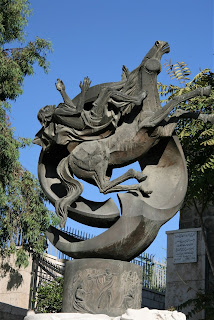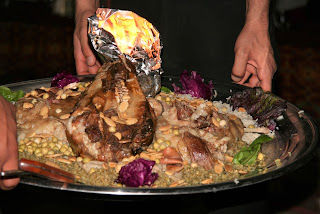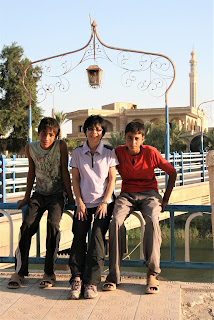Roam freely and safely in Syria in 2010
Part 1
(Travel Story Series @ Hon Too Fang 2021)
My friends,
My wife and I joined a 14-day semi back-pack tour to Syria and Lebanon in late September 2010. This is my "unconventional" account of the tour in Syria, a glimpse of it really.
Hon
(late evening, 20/10/2010)
Part A : General
A 1 - Why Syria
Friends are asking, "Why Syria?" There is a story. One day I was on the phone with a friend Peter who was asking me where would be my next travel destination. Suddenly my wife the Hokkien Char Boh was screaming at the laundry area, "Si lah, Si lah". Meaning “die lah”. Peter the oil and gas engineer heard it and said, "Oh, Syria, good choice. I have been to Damascus a couple of times, beautiful old city." Peter’s words are always inspirational in terms of travel. That was how Syria was chosen.
And why my Hokkien wife was screaming "si lah, si lah"? She put my dry-clean Lafuma winter jacket into the washing machine and started spinning. Gone case. That is not my problem. I have to deduct the replacement cost of RM 800 from her monthly allowance. That may take years.
A 2 - Why not Syria
Syria has a very old civilisation. Two thousand years ago, according to the book "Acts of the Apostles" in the Bible, Saul the Pharisee was converted to Christianity on the road to Damascus and became Paul the Saint. Now may be Hon the half-baked Catholic could become Paul the three-quarter-baked Catholic after visiting Damascus. The sun is still quite fiery in the Syrian desert in September, surely I could be baked a little bit more.
A 3 – Syria the country
The Syria Arabic Republic is a country with an area of 183,000 sq km (about 56% of Malaysia) and a population of 22 million. The country consists of mostly arid plateaus. The main economic sector is crude oil, about 40%, followed by agriculture, 20%.
It has a civilisation of over 5,500 years old. The region was named Assyria in ancient times. It was ruled by mostly foreign power, like the Babylonian, Persian, Greek, Roman, and then the Islamic dynasties, the last one Ottoman. After WW1, it became a colony of France, and achieved independence in 1946. It is currently ruled by the al-Assad family of the Ba’ath Party, Hafez from 1971 to 2000, succeeded by the son Bashar since 2000.
In terms of ethnicity, the main groups are Syrian Arabs, 82%, the Kurds 10%, Turks 5%. In religion, Sunni Muslims 74%, Shia Muslims 13%, Christians 10%.
(Note in 2021: since the civil war erupted in 2011, the above data are no more accurate. Half a million people have been killed, another 4 or 5 million became refugees in other countries. Many Christians have migrated, so less Christians now. One key contributing factor to the civil war is religion. The ruling al-Assad family and the key personnel are the minority Shia Muslims while the rebels are Sunni Muslims. That is why the al-Assad government is strongly supported by the Iranians who are mostly Shias)
A 4 - First lesson in Syria
It is said that shopping is the number one objective of all Malaysian tourists, not sight-seeing. The first thing the local tour guide, one Mr Murhaf, taught us when we boarded the bus at Damascus was how to read a price tag written in Arabic. Or more correctly recognise the numbers, 1, 2, 3, etc, written in Arabic. Syria does not have many non-Arab tourists because the US classifies her as a terrorist state. So price tags are mostly in Arabic, even in tourist spots. Murhaf the guide explained, "1 is 1, but 2 is a mirror image of 7, 5 is 0, 6 is 7, 7 is a v, and 8 is an inverted v...." Is this an entry test to get into the Malaysian Mensa (high IQ) Society? I gave up after 2 minutes.
A 5 - The safe terrorist state
When we are on tour in a foreign country, the first thing the local tour guide tells us is to be careful with our belongings, do not go to side-lanes alone, or at night. It may not be safe.
But in Syria, Murhaf the guide told us, "It is absolutely safe in Syria, go anywhere you like. Tourists being robbed? Unheard of." So my wife and I felt very safe roaming the narrow alleys in Damascus and Aleppo at 9 o'clock in the evening with 20,000 Syrian Pounds in our pockets. My wife would of course feel uneasy with RM 200 in her purse while walking along Lorong Selamat in downtown Penang in broad daylight at 9 in the morning. What, Lorong Selamat not "selamat"? Syria Boleh! 20,000 Syrian Pounds is RM 1,340.
We didn't see any beggar too. The guide explained that the local business communities would take care of anybody in need of help in their areas, like widows or orphans, etc. This terrorist state is not bad, but the ordinary Americans won't know that. Syria Boleh!
A 6 - The helpful and friendly host
We explored the cities on our own, see what we want to see. That is why we like this kind of semi back-pack tour. We just roamed around, armed with some simple city maps. But it is quite impossible to find a place if your map is in English and the actual street signs are in Arabic. When we took out our map at a street junction looking like lost, a group of young boys would appear out of nowhere trying to help. But they couldn't understand much English. We just said, "English? English?" They would flee immediately.
Scared of yellow faces speaking English? No, they actually went hunting for people who could speak English. They would return in a few minutes with one or two handsome young men (my wife's comment) who asked us in perfect English how they could help us. If they were not sure of the direction of the place we were going, they would ask the shopkeepers. They even helped us to speak to the taxi drivers. Syrians Boleh!
It was a hot day when we were visiting the ruins at Bosra. We were invited by a Syrian family to share some cold refreshments in the shade. Never experienced that elsewhere. Syrians Boleh! By the way, they drank Pepsi, the drink of their Number 1 infidels.
A 7 - Face book
The Syrians (and Lebanese too) are crazy about photos, or more exactly crazy wanting to be photographed. All the boys you have eye contact would ask you to take their photos. At the busy city streets where there was a traffic jam, even the adult drivers would wind down their car windows and asked us to take their photos. Never experienced that before. Simply incredible and we could not understand why. In fact we were sick of taking their photos after a few days. But women and girls would normally decline our approach to photograph them.
2 farmers at a local farmers' market near Dier ez-Zor and a woman shop-keeper in Latakia, and a fake Arab from Kuala Lumpur.

A 8 - Play "hi"
On the city streets we often met boisterous groups of youngsters who wanted to play "hi" with us. Saying "hi" in relatively high pitch. Ladies, don't worry, they are Syrians, not Cantonese. Go play "hi' with them. When they say "hi" to you, you also say "hi' to them! That is how to play "hi". As simple as that. Why you Cantonese lady blushing? What else are you thinking? You play "hi" differently?
A 9 - Ting Tong Tang
The Syrian boys like to ask, "What is your name?" We don't understand what is the significance of the question. Why they want to know the names of strangers. Some of them could recognise us as Chinese and would suggest names like, "Ting Tong Tang? King Kong Kang?" To them these are typical Chinese names! Not nursery rhymes! And of course some would mockingly asked, "Jackie Chan?" We were a party of 16 with 10 Chinese, 4 Malays, a Sarawak native and an Indian.
Part B : What to see in Syria
Plenty of new things to see and appreciate. Have a taste of Arab Muslim culture in a very dry region. Abandoned old cities dating back to Roman times. Castles and citadels dating back to the early Muslim dynasties and the Crusaders. Have a stroll on the banks of the Euphrates, the cradle of civilisation of the Middle East
We visited more than 10 towns/cities/ruins. Now we start touring, following our itinerary.
B 1 - Damascus - the capital
Damascus was inhabited since 10,000 to 8,000 BC. It is the capital and 2nd biggest city of Syria, with a population of 1.6 million. It is the oldest continuously inhabited city and capital in the world. The old city is a UNESCO World Heritage Site. Shown are street scenes.
Saw a Perdua Kancil here. Had dinner at a certain square surrounded with modern shops. The merchandise on display in the 3rd photo are soap bars, and that on the 4th are for daring ladies or may be limited as home wear.
Umayyad Mosque
The most famous sight is the Umayyad Mosque, completed in 715 during the Umayyad Dynasty. Big and old, one of the largest in the World. Some Muslims consider it the 4th holiest mosque in the World. Though in later years there were additions and alterations to the mosque the main structure as we see today is the same one built in the 8th century. Non-Muslims are allowed inside but ladies must put on some extra robes, 4th photo, shown with Karen. The 1st photo shows the façade near the entrance to the main prayer hall.
The mosque has 3 minarets, all later additions. The one shown is the Minaret of Qaitbay at the south-west corner built in 1488 during the Mamluk period. The other photos show, in order, the fountain in front of entrance to the main prayer hall, the Dome of the Clock and the Dome of the Treasury with Corinthian columns.
The next series are internal views of the main prayer hall, 136 m by 37 m. Shown the shrine of John the Baptist or Yahya in Arabic, a decorative lamp and the main mihrab (niche in wall to indicate the direction of prayer).
Al-Hamidiyah Souq
The souq (Arabic street market) is the other main tourist attraction. This is the main one in the city located near the Umayyad Mosque. It is 600 m long with a 10 m high arch cover, built around 1780. The end part of the souq is the ruins of the Roman Temple of Jupitar, 1st photo. Another old structure next to it is a bastion of the old citadel, 2nd photo. The souq sells everything and anything. Has anyone seen such "cucumber coils”?
Chapel of St Paul
In the New Testament book “Acts of the Apostles”, Saul of Tarsus was described as a persecutor of Christians shortly after the death of Jesus. One day he was riding from Jerusalem to Damascus to arrest these Christians, at that time outlawed in the Roman Empire. While entering a gate of Damascus, Jesus appeared to him in a bright light. He fell from his horse and was blinded for 3 days. After he regained his sight he was converted and began preaching to the people in Damascus. He was later known as Paul the Apostle or Saint Paul. The local Jews opposed to him wanted to kill him. But he managed to escape from the closed gate by lowering himself in a basket helped by his followers.
A chapel was later built at the place where he escaped and named the Chapel of St Paul. We had a short stop at the chapel. Shown a status depicting him falling from the horse.
B 2 – Bosra – an old Roman town
Bosra is about 135 km south of Damascus. The population now is about 20,000 but during the time of the Romans it was a prosperous regional centre and capital. It was taken over by the Muslims in 634 and continued to prosper due to trade until the 14th century. It started to decline after that. We visited the ruins of the old city which is a UNESCO World Heritage site.
The most outstanding monument is the huge 2nd century Roman Theatre which could seat 15,000. The theatre is well preserved because of the high fortification walls built by the Muslims in the 13th century as shown in the 2nd and 4th photos. The Muslims used the theatre as a citadel. The children simply love to be photographed.
Two photos to show the Islamic elements: a decorative panel and the Mosque of Omar, converted from a church and one of the oldest mosques in Syria. The minaret was added in the 12th century.
More of the ruins. The common rock type here is black basalt hence the columns and walls look black. The last photo shows our members hiding in the shade to listen to the explanation of the local guide on a very hot day. In fact everyday was a hot day.
B 3 – Palmyra - another vibrant old Roman city
Our next stop is Palmyra, about 250 km north-east of Damascus. Shown typical ground condition of the journey, mostly arid with small oasis here and there, at a highway stop where the souvenirs on sale are Roman helmets for soldiers, a funny-looking house and a productive olive tree at the modern town of Palmyra next to the ruins.
The old Palmyra is an ancient city which is a UNESCO World Heritage Site. It was a protectorate of the Romans, a rich regional centre due to trade and the prosperity funded the building of monumental projects. However in the 260s AD the local rebelled against the Romans and the city was levelled by the Romans in 273.
The 1st 2 photos show the general views. The ruins include the Temple of Baal, 210 m by 205 m, next 2 photos. It was the largest building in the Middle East in the first century AD.
The first 2 photos show respectively a funerary temple and a tetrapylon which is a Roman pavilion built at important crossroads to indicate directions. The next 2 show the monumental arch and the 1.1 km long colonnaded street.
(Note in 2021: Part of the ruins was destroyed by the ISIS in 2016 in the current civil war, including the tetrapylon)
More of the ruins and a group member taking his award-winning shot.
We had dinner at a tent-like restaurant just outside the ruins. A Syrian special with lamb as the main course and entertained by men dancing (photo blurred to show movement). Yes, fat men dancing, even the ladies also not interested. And a night shot of the lighted ruins.
(Note in 2021: this is the most impressive and extensive ancient ruins we have visited, compared to those we have seen in Iran, Turkey, Italy, Greece and Morocco. Hence more photos are posted for this site)
B 4 – Qasr al-Hayr al-Sharqi – a ruin in the desert
Our next stop is the city of Deir ez-Zor but on the way we stopped at this desert ruin of Qasr, about 110 km north east of Palmyra. It is an old castle built by the Umayyad Caliph around 729. It is 7 km by 4 km with many buildings including 2 palaces. One of the largest desert castles. It was destroyed by the Ottomans in 1638.
It was a very hot day during our visit. The facade at the main gate has been restored. The desert camels were underfed.
B 5 – Deir ez-Zor – a city by the Euphrates River
This is the largest city in eastern Syria with a population of 220,000. We did not visit any sight except walked from our hotel to the iconic suspension bridge over the great Euphrates River, one of the mother rivers of early human civilisations. The pedestrian bridge was constructed in 1927 and newly-weds came to photo shot here. The last photo was taken at a bus stop near our hotel. The boys just wanted to join in.
(Note in 2021: the iconic suspension bridge was destroyed by the rebels in 2014 during the current civil war)
Farmers’ market
On our way to Aleppo we stopped by a farmer’s market on the highway.
B 6 – Rasafa – another Roman ruins
On the way to Aleppo and 140 km from Deir ez-Zor is another old Roman city called Rasafa. The history of Rasafa is very similar to Bosra, a Roman city later taken over by the Muslims and abandoned after the 14th century. We had a brief stop here.
The 1st photo is a panoramic view of the ruins, the 2nd part of the perimeter wall. The 3rd shows the South Gate and the 4th a re-constructed wall of a basilica. The last 2 shows the remains of the cathedral.
To be continued ………..




























































































No comments:
Post a Comment